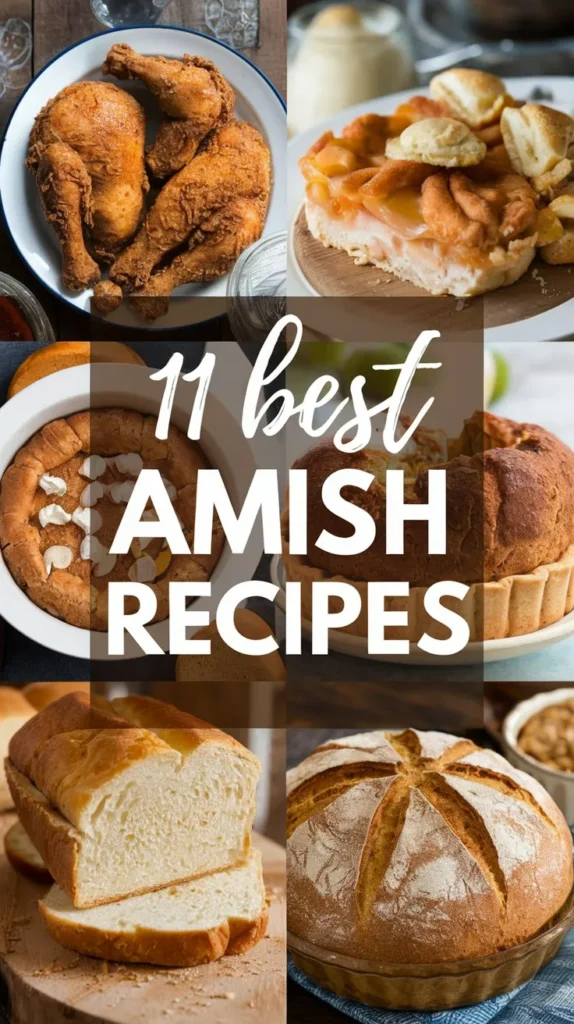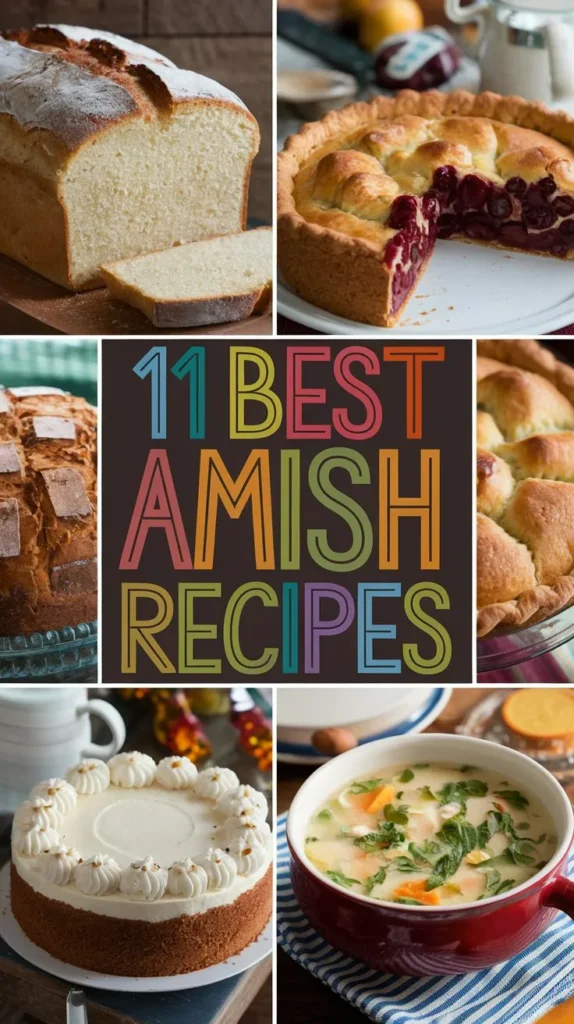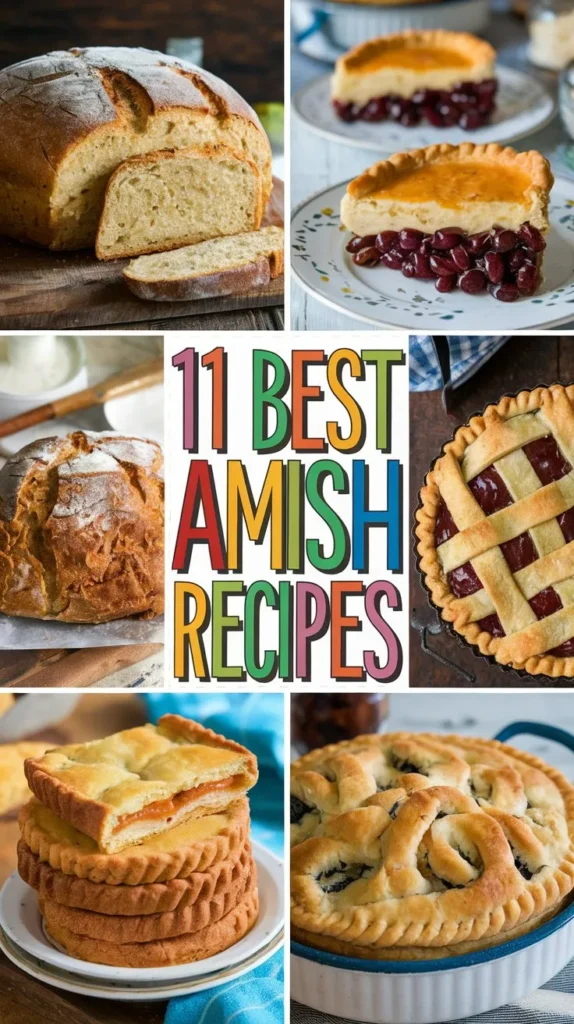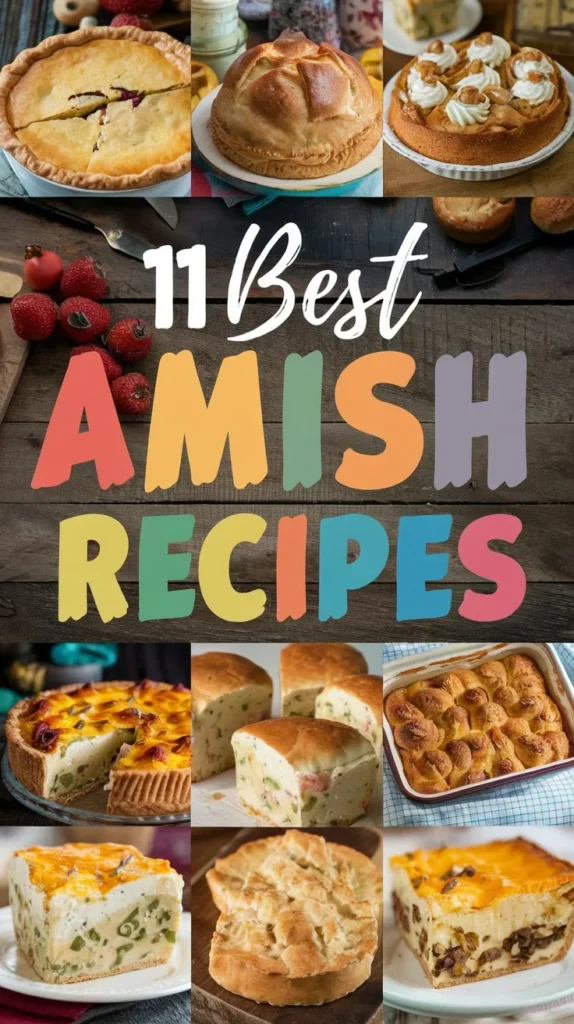11 Best Amish Recipes for a Delicious and Authentic Meal
As you explore the world of Amish cuisine, you’ll discover a rich tapestry of flavors and traditions that’ll make you want to gather ’round the table.
From sweet treats like whoopie pies and shoofly cake to comforting main courses like slow-cooked beef stew and chicken and noodles, these 11 recipes will transport you to a simpler time.
But what’s behind the Amish emphasis on locally sourced ingredients and time-honored techniques? And how do these recipes reflect the community’s values and way of life? You’re about to find out.
At a Glance
- Traditional Amish desserts like whoopie pies, shoofly cake, and apple dumplings showcase the community’s expertise in balancing flavors and textures.
- Classic Amish main courses, such as slow-cooked beef stew and roast beef with gravy, require patience and attention to detail for tender, fall-apart meat.
- Homemade pasta and noodles are a staple in Amish cuisine, adding depth and richness to comfort food dishes like chicken and noodles from scratch.
- Amish-style sides, such as creamy mashed potatoes with scallions, often feature fresh, high-quality ingredients and simple yet effective cooking techniques.
- Experimenting with unique flavor combinations and locally sourced ingredients helps to create distinct twists on traditional Amish recipes.

Classic Amish Whoopie Pie Recipe
You’re about to plunge into the quintessential Amish treat that’s a staple at every farmers’ market and family gathering: the classic Amish whoopie pie.
This sweet indulgence has been a mainstay of Amish cuisine for generations, with its origins dating back to the 1920s.
The original recipe consisted of two soft, moist cakes filled with a rich, creamy filling, typically made from Marshmallow creme or buttercream.
As you dig deeper into the world of whoopie pies, you’ll discover a wide range of filling variations.
Some recipes call for traditional ingredients like vanilla or chocolate, while others experiment with bold flavors like strawberry, raspberry, or even peanut butter.
The Amish community has perfected the art of creating unique flavor combinations, often using locally sourced ingredients to give their pies a distinct twist.
When it comes to the pie history, the Amish whoopie pie has undergone significant transformations over the years.
What started as a humble, homemade treat has evolved into a popular commercial product, with many bakeries and cafes offering their own versions.
Despite this, the traditional recipe remains a closely guarded secret, passed down through generations of Amish bakers.
As you set out on your own whoopie pie-making journey, remember that the key to success lies in the balance of flavors and textures.
With a little patience and practice, you’ll be able to create a classic Amish whoopie pie that’s sure to impress even the most discerning palate.
Shoofly Cake With Molasses Crust
Shoofly cake, a traditional Amish dessert, boasts a rich history and a flavor profile that’s both familiar and unique.
You’ll find its roots in the Pa Dutch traditions of the 17th and 18th centuries, when molasses was a staple ingredient in many recipes.
The name “shoofly” itself is believed to have originated from the fact that the sweet, sticky molasses crust would attract flies, which would need to be “shooed” away.
When you take a bite of shoofly cake, you’ll experience a delightful contrast of textures: the moist, crumbly cake and the crunchy, caramelized molasses crust.
The flavors are equally intriguing, with the deep, rich molasses balanced by the subtle sweetness of the cake.
It’s a true masterpiece of Amish baking.
As you explore the history of molasses, you’ll discover its significance in Pa Dutch traditions.
Molasses was a common sweetener in the 18th century, particularly among the Amish community.
It added depth and complexity to baked goods, and its robust flavor was a perfect match for the hearty, simple ingredients used in traditional Amish recipes.
When making shoofly cake, it’s crucial to use high-quality molasses for the best flavor.
Look for a thick, dark molasses with a robust aroma, and be prepared to spend some time stirring the mixture to achieve the perfect crust.
The end result will be well worth the effort, as you’ll be rewarded with a truly authentic Pa Dutch dessert that’s sure to become a family favorite.
Slow-Cooked Amish Beef Stew
Three key ingredients – tender beef, fresh vegetables, and slow-cooked broth – come together in perfect harmony in this traditional Amish beef stew recipe, a hearty, comforting dish that’s been passed down through generations of Pa Dutch cooks.
To guarantee tender beef, you’ll need to use a beef tenderizer, which breaks down the collagen in the meat, making it fall-apart tender. Don’t skip this step, as it’s vital to the dish’s success.
When it comes to cooking techniques, slow-cooking is the way to go. This method allows the flavors to meld together, and the beef to absorb the rich broth.
Brown the beef in a skillet before adding it to the slow cooker, as this step enhances the flavor. Add in fresh vegetables like carrots, potatoes, and onions, which will cook to perfection in the slow-cooked broth.
The key to a rich broth is to use a combination of beef broth and red wine. Yes, you read that right – red wine! It adds a depth of flavor that’s hard to replicate with other ingredients.
Don’t be tempted to skip this ingredient, as it’s what sets this stew apart from others. With these three key ingredients and cooking techniques, you’ll end up with a slow-cooked Amish beef stew that’s sure to become a family favorite.
Chicken and Noodles From Scratch
After savoring the rich flavors of slow-cooked Amish beef stew, it’s time to shift your attention to a classic comfort food that’s just as satisfying: chicken and noodles from scratch.
This dish is a staple in many Amish households, and for good reason – the combination of tender chicken, homemade pasta, and rich broth is a match made in heaven.
But what sets this dish apart from its store-bought counterparts is the attention to detail and care that goes into crafting each component from scratch.
To take your chicken and noodles to the next level, keep the following tips in mind:
- Don’t skimp on the chicken: Use high-quality, fresh chicken and experiment with different variations, such as adding lemon and herbs or using chicken thighs for added depth of flavor.
- Make your own pasta: Homemade pasta is a game-changer, and it’s easier than you think. Simply combine flour, eggs, and salt, then roll out and cut into thin strips.
- Use a flavorful broth: Don’t settle for bland, store-bought broth. Instead, simmer your chicken in a rich, homemade broth made with vegetables and aromatics.
- Add some texture: Add some sautéed vegetables, such as carrots and celery, to add texture and visual appeal to your dish.
Traditional Amish Apple Dumplings
Your grandmother’s secret recipe for traditional Amish apple dumplings is likely to become a staple in your household, too, once you master the art of wrapping tender pastry around crisp, sweet apples.
Apple history dates back to ancient times, with apples being a staple fruit in many cultures.
The Amish community, with their strong agricultural roots, has perfected the art of incorporating apples into their cuisine.
Dumpling variations abound, from sweet to savory, but traditional Amish apple dumplings stand out for their simplicity and elegance.
The key to success lies in the pastry dough, which should be flaky, yet delicate enough to hold its shape.
You’ll need to balance the sweetness of the apples with just the right amount of cinnamon and nutmeg.
Don’t overdo it – the goal is to enhance the natural flavors, not overpower them.
When wrapping the dumplings, be gentle yet firm, making sure to seal the edges tightly to prevent the filling from spilling out during baking.
A light dusting of sugar on top adds a delightful textural element.
As you take your first bite, the combination of tender pastry, crunchy apple, and hint of spice will transport you to a simpler time, when meals were made with love and care.
With practice, you’ll perfect the art of traditional Amish apple dumplings, and they’ll become a beloved tradition in your household, just like your grandmother’s.
Amish-Style Roast Beef With Gravy
Frequently on special occasions, you’ll find Amish families gathering around the table to savor a perfectly roasted beef, smothered in a rich, velvety gravy that’s been slow-cooked to perfection.
This iconic dish is a staple of Amish cuisine, and its preparation requires patience, attention to detail, and a deep understanding of the nuances of beef tenderization.
To achieve the perfect roast, you’ll need to:
1. Choose the right cut: Opt for a prime rib or top round roast, as these cuts are naturally more tender and have a more even fat distribution.
2. Season with care: Rub the roast with a mixture of salt, pepper, and herbs, making sure to coat it evenly to enhance flavor and texture.
3. Cook low and slow: Roast the beef in a preheated oven at 325°F (160°C) for 2-3 hours, or until it reaches your desired level of doneness.
Use a meat thermometer to certify the internal temperature reaches 135°F (57°C) for medium-rare.
4. Rest and slice: Once the roast is cooked, remove it from the oven and let it rest for 20-30 minutes before slicing it thinly against the grain.
This allows the juices to redistribute, making the beef even more tender and flavorful.
Creamy Mashed Potatoes With Scallions
Savor the rich, buttery aroma wafting from your kitchen as you whip up a side dish that’s sure to become a new family favorite: Creamy Mashed Potatoes With Scallions.
You’ll need high-quality potatoes, like Russet or Yukon Gold, that yield a fluffy interior and a smooth, creamy mash. Choose scallions with a sweet, mild flavor, such as Welsh onions or shallots, to add a subtle depth to your dish.
When it comes to mashed techniques, don’t over-mix! You want to preserve the natural texture of the potatoes.
Boil them until tender, then drain and add in butter, milk, and a pinch of salt. Use a ricer or food mill to break down the potatoes, then gently fold in the softened butter and milk until just combined.
Be patient and don’t overwork the mixture – you want a silky, smooth consistency.
Now, it’s time to add the scallions. Thinly slice the green onions and sauté them in butter until softened and fragrant.
Fold them into the mashed potatoes, along with a sprinkle of chopped chives for added freshness. Taste and adjust the seasoning as needed.
Your Creamy Mashed Potatoes With Scallions are now ready to be devoured alongside your Amish-Style Roast Beef With Gravy.
Old-Fashioned Amish Baked Oatmeal
After indulging in the rich flavors of Creamy Mashed Potatoes With Scallions, it’s time to shift gears and start the day off right with a hearty, comforting breakfast dish that’s sure to become a staple in your household.
Old-Fashioned Amish Baked Oatmeal is a traditional breakfast recipe that’s steeped in history and packed with nutritious benefits.
This recipe is a game-changer for those looking to shake up their morning routine and start the day off on the right foot.
Here’s what you’ll love about this recipe:
- Oatmeal benefits: Steel-cut oats are a great source of fiber, which can help lower cholesterol levels and keep you feeling fuller for longer.
- Breakfast traditions: This recipe is rooted in Amish tradition, where breakfast was a time for family and community to come together and share a meal.
- Easy to prepare: This baked oatmeal recipe is a cinch to prepare, requiring only a few ingredients and minimal prep time.
- Customizable: Add your favorite fruits, nuts, or spices to create a flavor combination that’s all your own.
Lemon Bars With a Shortbread Crust
Several decades ago, Amish women perfected the art of creating tangy, sweet, and crumbly lemon bars that would become a staple at community gatherings and family reunions.
You’ll find that their secret lies in the harmonious balance of flavors and textures, which you can achieve by following a few simple tips.
To start, you’ll need to make a rich shortbread crust, which serves as the foundation of these divine bars.
Don’t overwork the dough, or it’ll become tough and crumbly. Instead, mix the ingredients just until they come together in a cohesive ball. Press the dough into a baking dish, making sure to get it into the corners and up the sides. Then, bake it until it’s lightly golden, which will help prevent it from becoming too dark or bitter.
Now, it’s time to add the lemon filling.
Be sure to use freshly squeezed lemon juice and a generous amount of lemon zest, which will give your bars a bright, citrusy flavor. Don’t skimp on the sugar, either, as it helps balance out the tartness of the lemons.
Once you’ve mixed the filling ingredients together, pour them over the shortbread crust and bake until the filling is set.
When you take your first bite, the combination of the crumbly crust, tangy filling, and burst of citrus flavor will transport you to an Amish gathering, surrounded by warm smiles and comforting aromas.
Amish-Style Green Beans With Bacon
You’re likely still licking your fingers from those tangy lemon bars, but it’s time to shift your attention to a side dish that’s just as beloved in Amish country: green beans with bacon.
This classic combination is a staple at many Amish gatherings, and for good reason – the smoky, savory flavor of the bacon pairs perfectly with the tender crunch of the green beans.
When it comes to preparing this dish, there are a few key things to keep in mind.
1. Choose the right green beans: Look for fresh, tender beans with no signs of wilt or browning.
You can use either green or yellow beans, or a combination of both for a colorful twist.
2. Don’t overcook the bacon: You want the bacon to be crispy, but not burnt.
Cook it in a skillet over medium heat until it reaches your desired level of crispiness.
3. Add aromatics for depth of flavor:
Onions, garlic, and thyme all pair beautifully with green beans and bacon.
Saute them in the skillet with the bacon for added depth of flavor.
4. Experiment with bacon alternatives:
If you’re looking for a vegetarian option, try using tempeh or seitan instead of bacon.
You can also use different types of green beans, such as haricot verts or romano beans, for a variation on the classic recipe.
Flaky Buttermilk Biscuits From Scratch
Fresh from the oven, the sweet aroma of flaky buttermilk biscuits wafts through the air, beckoning everyone to the table.
You can’t help but salivate at the thought of sinking your teeth into one of these tender, golden-brown treats. But what makes them so irresistible? It’s the buttermilk, of course! The acidity in buttermilk reacts with the baking soda to create a tender, flaky texture that’s simply divine.
Plus, the lactic acid in buttermilk helps to break down the starches in the flour, resulting in a more tender, moist biscuit.
Now, it’s clear that you’re thinking: “But I’m not a fan of buttermilk.” Fear not, dear reader!
You can easily make a substitute by mixing 1 cup of milk with 1 tablespoon of white vinegar or lemon juice. Let it sit for 5-10 minutes, and voila! You’ve got a decent substitute.
But trust us, the real deal is worth the extra effort.
When it comes to biscuit variations, the possibilities are endless.
Try adding some chopped herbs like chives or rosemary for a savory twist, or some grated cheese for an extra burst of flavor.
You can even use different types of flour, like whole wheat or oat flour, to create a nutty, earthy flavor.
Whatever your preference, one thing’s for sure: these flaky buttermilk biscuits from scratch are sure to become a staple in your kitchen.
FAQs
Can I Use Modern Appliances in Amish Recipes?
When cooking traditionally, you’ll likely wonder: can I use modern appliances? Honestly, it’s a trade-off – electric mixers save time, but handcrafted tools preserve the authentic, labor-of-love essence; choose wisely, depending on your priorities.
Are Amish Recipes Suitable for Special Diets Like Gluten-Free?
You’ll find that many traditional recipes inherently cater to dietary restrictions, but adapting ancient practices to modern needs requires creativity; be prepared to modify and substitute ingredients to make them gluten-free, as authenticity often takes a backseat to necessity.
Can I Substitute Ingredients in Traditional Amish Recipes?
When you substitute ingredients in traditional recipes, you risk disrupting delicate flavor profiles and ingredient rations, so tread carefully, as even slight changes can substantially alter the dish’s character and authenticity.
Are Amish Recipes Difficult to Prepare for Beginners?
Honestly, you’ll need decent kitchen skills and cooking confidence to tackle traditional Amish recipes, which often require precise techniques and patience; without these, you might struggle, but with practice, you’ll master the art of Amish cooking.
Can I Store Amish Baked Goods at Room Temperature?
You’re wondering if you can store those freshly baked treats at room temperature? Honestly, it’s not the best idea, as they’ll likely become stale quickly. Instead, opt for fresh storage in airtight containers to guarantee a long shelf life.













DK Jacks is a passionate food enthusiast, recipe developer, and culinary explorer. With a love for both traditional and innovative flavors, DK brings a fresh perspective to the kitchen. When not experimenting with new ingredients, you’ll find DK capturing food moments through the lens or sharing cooking tips with fellow foodies.🍽️📸✨






